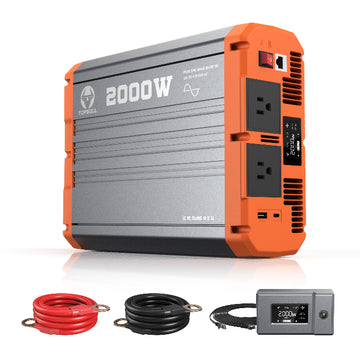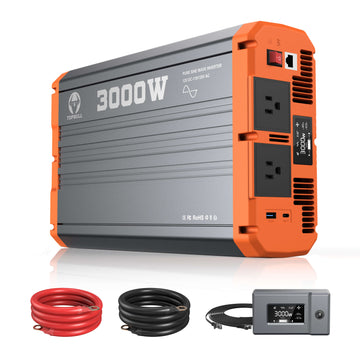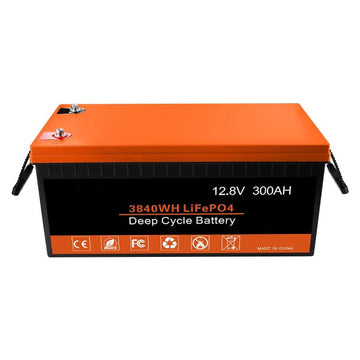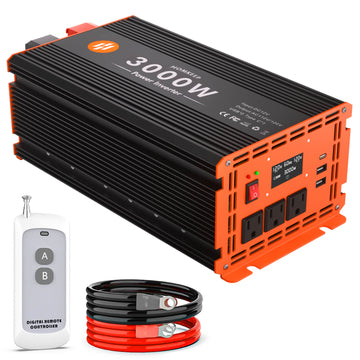Yes, you can plug an inverter into your cigarette lighter, but there are strict limitations to this option. This article will explain in detail the hidden safety hazards of cigarette lighter inverters and how to use them properly - whether you're a camping enthusiast, an RVer, or a homeowner in need of emergency power.
How do car cigarette lighters and inverters work?
A car cigarette lighter is a DC power interface whose circuit is directly connected to the vehicle's battery. When the vehicle is not started, the cigarette lighter voltage is about 12.6V (a fully charged battery); when it is started, the alternator stabilises the voltage at 13.5-14.5V.
However, the devices we use every day require AC power to operate, so we need an inverter. Cigarette lighter inverters, like regular inverters, convert DC power from the car battery to AC power through a high-frequency switch.
How many watts does the cigarette lighter provide?
The power of a cigarette lighter varies from vehicle to vehicle, depending on the power and function of the vehicle. The power of a cigarette lighter is determined by its voltage and current, usually 12V DC, with a maximum current of 10A (for small cars) or 20A (for some SUVs/trucks), depending on the vehicle model, which corresponds to a theoretical power limit of 120W or 240W.
In practice, due to aging wiring, voltage fluctuations, etc., it is recommended to retain 20% safety redundancy, i.e., the actual available power of the cigarette lighter in a small car should be no more than 100-150W, and in a high-current model, no more than 200 W. This power output is usually sufficient to meet your needs for charging small devices such as a cell phone, a lamp, or a laptop computer.

Cigarette lighter limitations on the inverter
Many car owners are accustomed to using their inverters by plugging them directly into their car's cigarette lighter socket because it seems convenient and quick. But in fact, the cigarette lighter has significant limitations on the performance and safety of the inverter.
When you push the cigarette lighter plug into the socket, the internal spring-loaded contacts close the circuit, allowing current to flow through the built-in 10-15A fuse to the load device. However, car cigarette lighters were not originally designed to power high-power devices, and they can only support low-power inverters (≤150W), which will not meet the needs of most household appliances.
If you try to connect an inverter rated at 300W or more, the sustained high current may blow the fuse, preventing the wiring from overheating or catching fire. Especially if the engine is not started and is powered only by the battery, using the cigarette lighter connector to connect a high-power inverter is more likely to trigger a sudden drop in system voltage.
What can you plug into the cigarette lighter inverter?
Due to the current capacity and power limit of the cigarette lighter, only low-power devices that draw less than the rated current of the cigarette lighter circuit are suitable for use with this type of inverter. The following are some common devices that are suitable for plugging into a cigarette lighter inverter:
| Devices | Power Range |
| Laptops | 45-90W |
| Cell Phone Chargers | 5-20W |
| Portable Mini Fans | 5-15W |
| Camera Battery Chargers | 8-25W |
| Drone Chargers | 30-90W |
These above devices have low power consumption, typically between 40W and 90W, and are low power loads, ideal for powering through cigarette lighter inverters.
Learn More: How to Choose a Power Inverter for Car Cigarette Lighter Use?
Common misconceptions and risks of cigarette lighter inverters
Power misconceptions
Some users will purchase a 300W inverter thinking, “I can just use half the power”. However, the cigarette lighter fuse in most vehicles is rated at 15A, so even if you only use half the power of a 300W inverter, it is already very close to the upper limit of the cigarette lighter's current. Once the voltage drops slightly or the inverter efficiency fluctuates, it may instantly exceed 15A, causing the fuse to blow.
Peak current
Many users often encounter the problem of sudden power failure of the inverter or the cigarette lighter connector heating up when they use electric motor-type devices (such as car refrigerators, air pumps, and small vacuum cleaners) in their cars. This is mainly due to the current peak at the moment of starting.
When motorized equipment is started, the current can reach 2-3 times its rated value. This problem often occurs when the device “just plugged in and then jumped off”; it seems that there is a fault in the inverter, but in fact, the current is instantly too large to trigger the activation of the protection mechanism.
Fuse replacement
Some users try to solve the problem of inverter jumping by replacing the cigarette lighter's 10A fuse with a larger 15A or 20A fuse, a practice that has serious pitfalls. The purpose of a fuse is to protect the wiring itself, and it is precisely designed for the carrying capacity of the wires in the circuit. If you replace it with a larger fuse, once the current is overloaded, the wiring itself may be damaged before the fuse, causing the wires to overheat, melt, or even start a fire. The solution should not be to replace the fuse but to use a battery direct-connected inverter that meets the power requirements.

Cigarette lighter inverter safe use recommendations
Strictly match the load power
When using the device, carefully check the power of the device, and the total load should not exceed 80% of the rated power of the inverter. Although some cigarette lighter inverters are labeled up to 150W or higher, it is recommended that the actual power used be limited to 120W or less. This allows enough margin for the inverter's losses and instantaneous current fluctuations to avoid triggering the fuse protection. Especially in long-time power supply scenarios, the load should be carefully controlled to avoid overheating of the wiring.
Avoid prolonged use
For slightly more powerful devices, avoid prolonged use and turn them off after 15 minutes of operation. Also, ensure that the vehicle is started to utilize generator power to prevent battery loss.
Check plug and connector temperatures periodically
During operation of the inverter, the cigarette lighter plug and surrounding area should be watched for abnormal heat. If you find that the temperature continues to rise, it may be due to poor contact, excessive load, or aging of the socket. In this case, you should immediately disconnect the power and troubleshoot to avoid damaging the socket or even inducing an electrical fire due to melted connectors.
Pairing the inverter directly to the car battery
For inverters larger than 150W, you can also try connecting them to the car battery. The car battery can provide higher and more stable current support than the cigarette lighter port.
Benefits of connecting the inverter to the car battery:
- Provide higher current support, adapting to 300W, 500W and even 1000W inverters.
- Reduce the voltage loss caused by wire resistance and improve the inverter efficiency.
- Avoid poor contact due to heat loosening or erosion of the cigarette lighter plug.
- Optional special connecting cable with fuse for added safety protection.
How to connect an inverter to a car battery
1. Turning off the Vehicle and Inverter: Make sure that both the vehicle engine and the inverter are turned off before starting the connection to avoid short circuits or sparks.
2. Selecting the right connection cable: Use a matching battery clip cable with a wire gauge thick enough (e.g., 8 AWG or thicker) to carry the inverter power.
3. Connecting the positive (red) cable: Connect the red wire clamp on the inverter to the positive (+) terminal on the car battery and then to the positive connector on the inverter.
4. Connecting the negative (black) cable: Connect the black wire clip to the negative (-) terminal of the battery or the car body ground and then to the negative connector of the inverter.
5. Check that the connection is firm: Make sure that the cable is not loose and the wire clip is tight to avoid misfiring or unstable voltage.
6. Start the vehicle, then turn on the inverter: Start the vehicle first to stabilize the voltage, then turn on the inverter to start the power supply.
FAQ
Q: Can I use the 300W inverter with a cigarette lighter?
A: No, it is not recommended. Cigarette lighters typically support up to 150W, and using a 300W inverter can overload, which could blow a fuse or cause a risk of overheating.
Q: Will a cigarette lighter drain my car battery?
A: Yes, especially if you use the device for a long time with the engine off. It is recommended that you start your vehicle or check the voltage regularly to avoid a dead battery.
Q: What devices are safe to use with a cigarette lighter inverter?
A: Cell phone chargers, laptops, small fans, camera/drone battery chargers, and other devices under 120W are safe.












